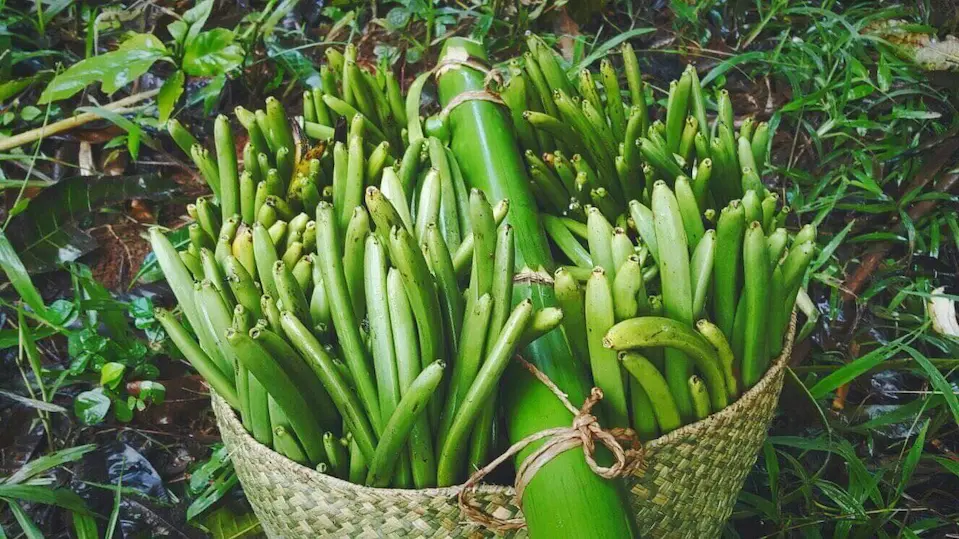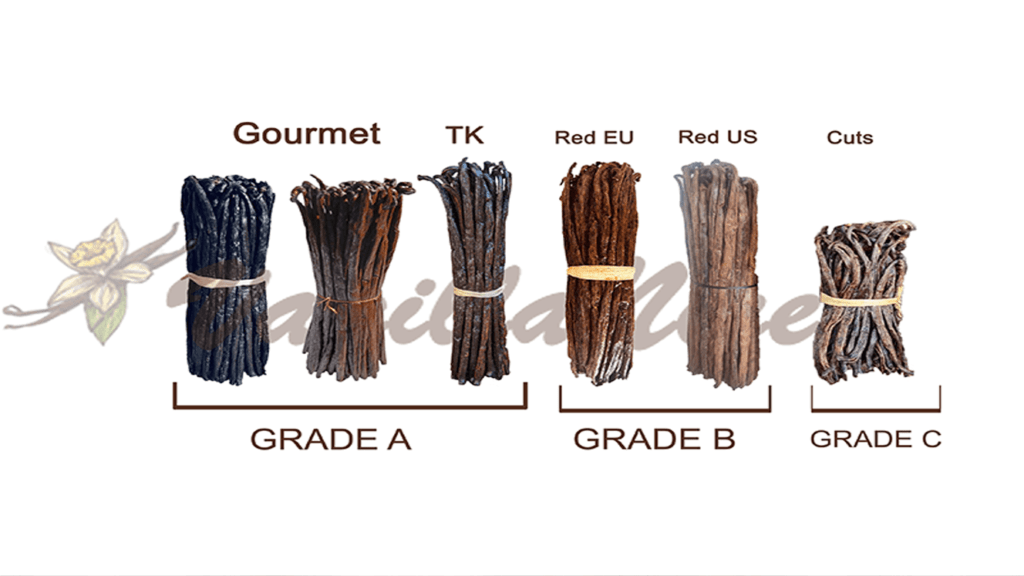The Fascinating World of Vanilla Beans: Origins, Production, and Futures

Welcome to the captivating universe of vanilla beans! These aromatic wonders, native to Central and South America, have found their way into kitchens worldwide. This guide will take you on a journey through the history, types, and culinary applications of vanilla beans.
The Origin and History of Vanilla Beans
Vanilla beans have a rich and storied history that dates back to ancient times.
The original home of vanilla is Central America, specifically Mexico, where it was used by the Aztecs and Mayans in various culinary and medicinal applications. The Aztecs called vanilla “tlilxotchitl,” which translates to “black pod.”
They carefully prepared it to be used in sacred beverages that were believed to connect them with the gods.
When the Europeans, led by Hernán Cortés, arrived in Mexico in the 16th century, they were introduced to a beverage made of chocolate and vanilla.
Enchanted by its aroma, they brought back vanilla plants to Europe, where it quickly gained popularity.
The Spanish were particularly fond of it, and by 1664, it had made its way to France.
The Journey of Vanilla to Madagascar
In the early 19th century, vanilla cuttings were introduced to the island of Réunion.
Despite the plants growing and flowering, they did not bear any fruit.
This was because the natural pollinators of the vanilla flower, a specific type of bee and hummingbird, were not present on the island.
The mystery of vanilla pollination was finally solved in 1841 by a young slave named Edmond Albius, who discovered a method to hand-pollinate the flowers using a thorn from a wild lemon tree. This breakthrough marked the beginning of the global spread of vanilla cultivation
Vanilla was introduced to Madagascar in 1870 from Réunion, another french colony , and the results were impressive. By 1924, Madagascar had become the world’s leading producer of vanilla, producing 300 tons annually.
Today, Madagascar continues to be a major player in the global vanilla market, along with other countries like Indonesia, China, and Mexico
The Vanilla Orchid and the Birth of a Vanilla Bean
The vanilla orchid is a fascinating plant that belongs to the genus Vanilla in the orchid family.
There are several species within this genus, but the most commercially valuable is Vanilla Planifolia.
This evergreen vine can reach up to 20 meters in length, with thick stems and greenish to yellow flowers.
The fruits of the plant are long, thin pods that contain thousands of tiny, black seeds, which are the coveted vanilla beans.
The Vanilla Planifolia has fleshy aerial roots that cling to trees and allow it to climb, making it a sight to behold in its natural habitat.
Other species, such as Vanilla Tahitensis and Vanilla Pompona, are also used in the production of vanilla products
Madagascar vanilla plant
The cultivation of vanilla beans is a labor-intensive process that requires a lot of care and attention.
The growth and cultivation of the vanilla bean plant is a process that takes about nine months. The plant needs a specific climate to grow, which is why it thrives in countries like Madagascar. The plant is a vine, and it grows by climbing up an existing tree or a manmade structure.
Once the vanilla bean plant is mature, it will start to produce flowers. These flowers are pollinated by hand.
After pollination, the flowers will produce green pods, which are the vanilla beans. These beans are harvested by hand and then go through a curing process to develop their flavor

Madagascar wild vanilla
For a more detailed look at the process of growing vanilla beans, you can check out this article on our website: How are Vanilla Beans Grown? A Comprehensive Guide from a Madagascar Farmer.
This article provides a step-by-step guide on how vanilla beans are grown, straight from a seasoned farmer from the SAVA region of Madagascar.
Types of vanilla Bean
Vanilla Planifolia
This is the most common type of vanilla and it’s often referred to as Madagascar or Bourbon vanilla. It’s known for its strong, creamy, and sweet flavor that’s perfect for a wide range of dishes. This type of vanilla is grown in Madagascar and the surrounding Indian Ocean islands, including Comoros and Réunion, the latter of which was formerly known as Bourbon Island.
Vanilla Tahitensis
This type of vanilla is grown in Tahiti and other regions of the South Pacific. It’s a mutation of Vanilla Planifolia and has a lighter, more floral flavor with notes of cherry and anise. It’s often used in dishes where a more subtle vanilla flavor is desired.
Vanilla Pompona
This is a less common type of vanilla that’s grown in the West Indies, Central, and South America. It has a sweet, coumarin-like flavor and is often used in perfumes and aromatherapy.
Major vanilla in Madagascar is vanilla planifolia , therefore they also begin to produce tahitensis and pompona for international market
The Curing Process of Vanilla Pods
The curing process of vanilla beans is a meticulous and labor-intensive journey that takes several months to complete.
It begins with the harvest of the beans, which are initially green and start to yellow as they ripen. It’s important to note that the pods must be allowed to ripen naturally on the vine, as picking them too early can result in a sour and bitter flavor
The curing process is divided into four main stages:
- Dipping
- Sweating
- Drying
- Conditioning

The Grading of Vanilla Beans
The grading of vanilla beans is a crucial aspect of the vanilla industry, affecting everything from pricing to the end use of the beans.
The primary grades include Grade A, Grade B, and Grade C, each with unique characteristics and uses.
Factors such as moisture content, vanillin content, length, color, and oiliness influence the quality and grade of a vanilla pod.
To learn more about the intricate grading system of vanilla beans and their impact on the international market, check out our detailed article on Madagascar Vanilla Bean Grades .
The Difference Between Pure and Artificial Vanilla Flavor
Vanilla, often perceived as a simple or plain flavor, is actually one of the most complex flavors in the world.
With over 250 flavor compounds or molecules contributing to its profile, vanilla is anything but ordinary.
The primary flavor component in vanilla beans is vanillin, but the symphony of other compounds gives each type of vanilla its unique character. This complexity is part of what makes vanilla such a versatile and universally loved flavor.
The pure vanilla flavor is derived directly from the beans of the vanilla plant. It carries a depth and richness that is hard to replicate.
Each bean is a treasure trove of flavor, offering a taste that is at once sweet, creamy, and perfumed with a hint of floral notes.
On the other hand, artificial vanilla flavor, also known as vanillin, is a synthetic version of the compound that gives vanilla its flavor.
While it may mimic the taste of real vanilla to some extent, it lacks the depth and complexity of pure vanilla. It offers a more straightforward vanilla taste, missing the subtle notes and nuances that come with natural vanilla.
Why Are Vanilla Beans So Expensive?
Vanilla beans are renowned for their high cost, often being second only to saffron in terms of price per weight. This is largely due to the labor-intensive and time-consuming process involved in their production.
- Vanilla vines take two to four years to fully mature, and their flowers only bloom for one day of the year. This necessitates manual pollination, a meticulous task that must be done by hand.
- After pollination, the beans require a nine-month maturation process on the vine. Once matured, the beans are not immediately ready for use. They must undergo a curing process which can take up to six months.
- The majority of the world’s vanilla beans are produced in Madagascar, with other significant producers including Indonesia, Tonga, and Tahiti. The global demand for vanilla, particularly from major markets like the United States and Europe, often outstrips supply, leading to high prices.
Furthermore, the quality of the beans can significantly impact their price.
Beans harvested too early, for instance, are of lower quality and thus less valuable.
The grading of the beans, based on factors such as moisture content and appearance, also plays a role in determining their cost.
Climate change and weather conditions in the growing regions further contribute to the high cost of vanilla beans.
Unfavorable weather can lead to failed crop yields, reducing the supply of beans and driving up prices.
For instance, cyclones in Madagascar have previously caused significant damage to vanilla crops, leading to a surge in prices.
The Future of Vanilla
The future of the vanilla industry is a subject of considerable interest and concern, given the challenges it faces. These include climate change, market fluctuations, and the labor-intensive nature of vanilla cultivation.
Climate change, in particular, poses a significant threat, as alterations in weather patterns can lead to increased instances of drought and cyclones, which can devastate vanilla crops.
This is a reality that farmers like Cloteur and Roger Arison in Madagascar, the world’s leading producer of vanilla, have experienced firsthand. Their experiences and concerns are detailed in their respective articles: Vanilla Farming in Madagascar: A Journey by Roger Arison and How are Vanilla Beans Grown? by Cloteur.
Despite these hurdles, the vanilla industry displays resilience and potential for growth.
Their stories remind us that the future of vanilla is not just about market trends, but also about the people and communities who cultivate this precious crop.
According to a report by GlobeNewswire titled “The Worldwide Vanilla Market Industry is Expected to Reach $1.9 Billion by 2028”, the global vanilla bean market will grow at a CAGR of 5.5%, reaching a revenue of US$ 2.1 billion between 2022 and 2032.
As we look to the future, the sweet scent of success for the vanilla industry lies in embracing change, fostering resilience, and nurturing global partnerships



Pingback: Vanilla Bean Grades - Vanillanice.com | Madagascar Vanilla-7
Pingback: 5 essentials ways to how to store Vanilla Beans